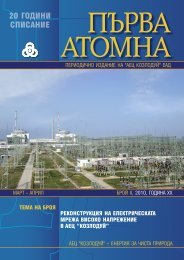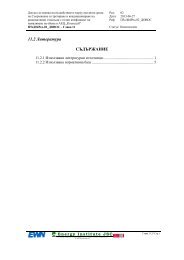Summary Report for Conduct of Kozloduy NPP Stress Tests
Summary Report for Conduct of Kozloduy NPP Stress Tests
Summary Report for Conduct of Kozloduy NPP Stress Tests
You also want an ePaper? Increase the reach of your titles
YUMPU automatically turns print PDFs into web optimized ePapers that Google loves.
“<strong>Kozloduy</strong> <strong>NPP</strong>” PLC<br />
SUMMARY REPORT<br />
<strong>for</strong> <strong>Conduct</strong> <strong>of</strong> <strong>Kozloduy</strong> <strong>NPP</strong><br />
<strong>Stress</strong> <strong>Tests</strong><br />
For the degree <strong>of</strong> piling with debris <strong>of</strong> 100% results <strong>of</strong> calculations with conservative<br />
assumptions show that the maximum temperature <strong>of</strong> the cladding may be only exceeded<br />
accordingly after more than 2 or 3 days.<br />
Considering the structure <strong>of</strong> the ro<strong>of</strong> a realistic degree <strong>of</strong> burial with 50% confidence should<br />
be anticipated. This increases the time available <strong>for</strong> countermeasures to more than 7 days. Even <strong>for</strong><br />
this worst case scenario <strong>of</strong> an accident with loss <strong>of</strong> heat removal there is sufficient time available to<br />
take adequate countermeasures, i.e. to remove the debris and restore natural ventilation.<br />
2.7.3.2 Potential loss <strong>of</strong> <strong>of</strong>f-site power due to destruction <strong>of</strong> the main site infrastructure<br />
The scenario <strong>for</strong> total loss <strong>of</strong> power supply is not relevant with regard to DSFS safety. Due<br />
to availability <strong>of</strong> passive system <strong>for</strong> decay heat removal the safe mode <strong>of</strong> the storage facility<br />
operation does not depend on the power supply.<br />
2.7.3.3 Other indirect impacts caused by fires, explosions, flooding<br />
The earthquake as an initiating design basis event may cause a fire, which indicate thermal<br />
effects on the containers.<br />
To avoid negative effects on safety resulting from fire the following provisions are made:<br />
· primary fire protection is provided by the design though minimizing potential<br />
sources <strong>of</strong> ignition and fire loads.<br />
· in case <strong>of</strong> fire occurrence the DSFS building is provided with fire detection system.<br />
· design fire protection <strong>of</strong> the containers. The containers are designed to withstand<br />
severe boundary accident event <strong>of</strong> a fire at a constant temperature <strong>of</strong> 600 ° C with a duration<br />
<strong>of</strong> 1 hour while maintaining the temperature <strong>of</strong> the fuel cladding below 330° C.<br />
In the design <strong>of</strong> containers and DSFS building scenario <strong>of</strong> an explosion <strong>of</strong> the site or an<br />
explosion <strong>of</strong> a vehicle near DSFS is not considered. The internal explosion can be excluded since<br />
there are no explosive materials within the facility.<br />
The building <strong>of</strong> the DSFS storage hall is designed to withstand the pressure wave from the<br />
explosion <strong>of</strong> a gas cloud. However, it can not be excluded that construction debris from the ro<strong>of</strong><br />
(thin metal plates) could fall into the storage hall. The emergency procedures and instructions shall<br />
specify the way and the process tools required <strong>for</strong> removal <strong>of</strong> the debris.<br />
2.8 POTENTIAL DESTRUCTIONS OUTSIDE THE SITE LEADING TO PREVENTION<br />
OR BLOCKING OF PERSONNEL OR EQUIPMENT ACCESS TO THE SITE<br />
To take into account possible adverse effects <strong>of</strong> seismically induced damage to the national<br />
infrastructure around the plant on its ability to maintain their safety functions after the seismic event<br />
it is necessary to conduct studies that show when and how seismic failures and the damage can be<br />
anticipated in it. Possible adverse effects on the plant are mainly limited to:<br />
85/202

















